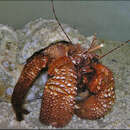en
names in breadcrumbs


Petrochirus diogenes is large enough that it can inhabit a fully-grown shell of the Queen Conch, Strombus (or Eustrombus) gigas. It can attack and eat a conch, thus obtaining both a meal and a shell (Iversen et al. 1986).
Bertini and Fransozo (2000) studied the use of shells by Petrochirus diogenes in the Ubatuba region along the northern coast of São Paulo State, Brazil. The 634 P. diogenes specimens (405 males and 229 females) were using shells from a total of 12 different gastropod mollusk species, as follows (% of sampled crabs using each species in in parentheses): Tonnea galea (60.6), Zidona dufresnei (16.1), Strombus pugilis (7.4), Phalium granulatum (4.2), Cymatium parthenopeum (4.2), Stramonita haemastoma (2.2) Olivancillaria urceus (2.2), Adelomelon beckii (1.3), Buccinanops gradatus (1.3), Siratus tenvivaricosus (0.47), Fusinus marmoratus (0.31), and Cypraea zebra (0.16). Most shells had epibionts as well (barnacles, tube-dwelling polychaetes, bryozoans, sea anemones, seaweed, and bivalves). Tonnea galea shells, by far the most commonly used shells in this study, have a large aperture width (opening) and low average weight. It is not clear to what degree T. galea shells are actively favored by Petrochirus diogenes versus simply most available. Small hermit crabs inhabited a wide variety of gastropod shells due to their higher availability. However, the utilization of T. galea shells became predominant as the crabs attained larger sizes.(Bertini and Fransozo 2000)
In a study in Beaufort Harbor, North Carolina (U.S.A.), Kellogg (1977) reported that the small number of P. diogenes encountered inhabited 3 shells: Nassarius obsoletus (n=1), Polinices duplicatus (n=3), and Terebra dislocata (n=3). Bertini and Fransozo (2000) note that P. duplicatus was present in their study area in Brazil, but they found no instances of its use by P. diogenes.
None of the P. diogenes collected from Beaufort Harbor were sexually mature. Offshore, however, much larger specimens of P. diogenes were collected, many of which were sexually mature. Kellogg concluded that P. diogenes probably does not maintain a viable breeding population around the harbor, but that stray larvae may drift into the estuary from offshore. Some of these larvae apparently locate unused shells which occur in the channels. Shells inhabited by P. diogenes usually were heavily fouled, unlike those found in other areas, and unlike those inhabited by the other species. Petrochirus diogenes does not prefer shells in this condition. When placed in holding tanks containing a wide variety of shells (conditions, sizes, and species), the P. diogenes specimens readily abandoned their orginal shells for clean ones.
Perry and Larsen (2004) report that this species inhabits tun and murex shells offshore, with young specimens inhabiting Polinices, Busycon and Terebra dislocata shells.
Petrochirus diogenes is a large marine hermit crab, inhabiting a wide variety of shells. It occurs from North Carolina through the Gulf of Mexico to Brazil, including the West Indies (Perry and Larsen 2004).
Petrochirus diogenes has the shield with scattered clumps of setae, the anterior margin trilobate. The chelipeds are massive and unequal, the right being slightly larger than the left. The hands and carpus of the chelae are roughened with grouped tubercles separated by appressed setae. The body is generally red in color. The chelipeds are reddish except between the fingers; there are white spots on carpal area. The walking legs have purple bands. (Perry and Larsen 2004)
Petrochirus diogenes occurs from North Carolina through the Gulf of Mexico to Brazil, including the West Indies (Perry and Larsen 2004).
Petrochirus diogenes occurs from North Carolina, Gulf of Mexico, and Antilles to Venezuela, Surinam, Brazil and Uruguay (Raz-Guzman et al. 2004).
Petrochirus diogenes is found on mud, mud/shell, and sand bottoms from nearshore to 128 meters depth (Perry and Larsen 2004).
Petrochirus diogenes is found from 18 to 128 meters (Wenner and Read 1982, cited in Raz-Guzman et al. (2004).
Petrochirus diogenes is found on coastal jetties; muddy, sandy, and shelly bottoms; on shrimping grounds; and in turtlegrass (Thalassia testudinum) beds (Raz-Guzman et al. 2004 and references therein).
In a study of hermit crabs in southeastern Brazil, Leite et al. (1998) found P. diogenes only in the infralittoral zone (the region of shallow water closest to the shore, but beyond the intertidal zone), occasionally associated with soft substrata.
Petrochirus diogenes is a giant marine hermit crab. This species lives in the Caribbean Sea, and often inhabits conch shells.[1] This species of hermit crab is large enough that it can inhabit a fully grown shell of Lobatus gigas. It will attack and eat a conch, thus obtaining a meal and a shell.[2] It was originally described by Carl Linnaeus as Cancer diogenes;[3] the specific epithet honours Diogenes of Sinope.[4]

Petrochirus diogenes is a giant marine hermit crab. This species lives in the Caribbean Sea, and often inhabits conch shells. This species of hermit crab is large enough that it can inhabit a fully grown shell of Lobatus gigas. It will attack and eat a conch, thus obtaining a meal and a shell. It was originally described by Carl Linnaeus as Cancer diogenes; the specific epithet honours Diogenes of Sinope.
 Petrochirus diogenes in a subadult shell of Eustrombus gigas
Petrochirus diogenes in a subadult shell of Eustrombus gigas